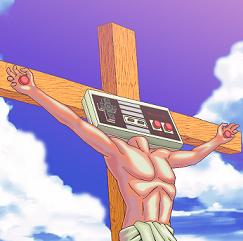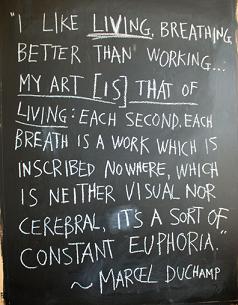[Editor's Note: This is a Vox Pop feature, a community editorial written by a Game Revolution user. This article was chosen by Game Revolution as an exceptional piece that deserves to be highlighted. The original article has been professionally edited, and the final edit below has been approved by the original author for any changes made and as a feature on the site. If you would like to see your work featured on Game Revolution, please see the contest guidelines here.
The views expressed in this article do not necessarily reflect those of Game Revolution or its employees.]
In 1917 Marcel Duchamp bought a urinal, wrote a name and a date on it, made no other changes whatsoever, and submitted it to an art show as a piece called Fountain. It was never displayed, presumably thrown out, and has been lost ever since. Now every reproduction of the piece is either owned in a private collection or on display in a museum, including the San Francisco Museum of Modern Art, the Philadelphia Museum of Art, and the Tate Modern. The precedent set by Fountain’s inclusion in these various art collections easily umbrellas over most things being criticized as ‘not art’, including video games.
There is, of course, a very long-winded philosophical process of people coming to the consensus that a urinal is art. I certainly do not know all the names involved and you probably wouldn’t want to read them anyway. To expedite this process I will abridge the rationale and show that the academic consensus is already decided on the matter. Even this early in the argument, saying video games are not art would be close to refuting the standard of some of the most esteemed art museums in the world.
The ironic part is that video games would still be art even if we didn’t play them. The cartridges and CDs would constitute an entirely different art form by the accepted definition. In fact, the lines of code would be art before any type of production had begun. Once again, there is a very compelling history to this debate. At the moment, though, how about we just look at the Oxford American Dictionary definition and assume the people responsible for crafting these definitions actually put some research into the matter beforehand:
art (noun): the expression or application of human creative skill and imagination, typically in a visual form such as painting or sculpture, producing works to be appreciated primarily for their beauty or emotional power.
That is wide open. Let’s look at the most important words here: “expression or application of human skill and imagination” and “producing works with beauty or emotional power”. How conveniently vague. I wonder why the incredibly educated institution of Oxford would be so hesitant to write off any possible types of art with their word choices? Here’s why: the incredibly educated institution of Oxford actually has its finger on the academic pulse and realizes it would be hard pressed to think of something that isn’t art.
The only actual parameters imparted in the definition are these:
Art requires human attention to be art.
Imagination comes automatically with perception. By definition, all ‘imagination’ is the formation of things not apparent to the physical senses. The definition of “creative” follows suit so neatly that the word “imagination” is actually used in its definition. That is literally as simple as looking at a tree and recognizing it by the fabricated word and combination of phonetics we arbitrarily assigned to it. Needless to say it would be nearly impossible to observe anything without utilizing that good ol’ human imagination. (As an aside, I want everyone to know I had to violently suppress the urge to type “arbortrarily” during my tree example.)
 Works of art must be appreciated for their beauty or emotional power.
Works of art must be appreciated for their beauty or emotional power.
That section of the definition is absolutely subjective, bordering on meaningless. “Beauty” may as well be synonymous with “things someone at some point kind of liked”. “Emotional Power” sounds like the power of the South American kid with the monkey from Captain Planet. Needless to say, it is equally undefinable. However, this part of the definition does reconfirm that art requires human attention since obviously no fern is going to have a strong emotional appreciation for the hit Michael Jackson album Thriller.
Really, the debate centers on this one word, the most troublesome of the still completely agreeable definition:
Works of art must be produced.
The fog-breathing limeys at Oxford don’t help us as much here. The troublesome definition to this argument is the one that requires manufacturing from components or raw materials. The useful definition simply states “causing to happen or come into existence”. Now, finally and really for the first time, we do have at least an attempt at setting restrictions upon what is art. It must be produced from some other tangible material.
Well, this attempt at restriction is easily dispatched. What about dance, stand up comedy (Carrot Top and Gallagher are unfortunately not given amnesty from this restriction), rhetoric in its entirety when not written down, singing, or any perspective/frame that would work in a photograph or painting but is not photographed or painted? Clearly, “raw material” is out and “component” is too vague to restrict anything. Yes, video games as art aren’t being criticized for not satisfying that requirement, but I’m not concerned solely with the easily defended video game. Now this is the objective, bare-bones philosophical root of the matter. Any more artistic use of the word “art” from, oh say, Roger Ebert is really a different word that means "stuff I like as opposed to stuff I don't like".
Now for some troubleshooting. First, things do not have to be presented in a viewing context to be art. By this I mean frames, photographs, drawings, paintings, books, and everything else that goes in museums. The actual production of a product is not required; for example, dance. The seats at a ballet recital being empty do not make the recital less artistic.
When people view a sunset they first observe the stirring beauty of the sunset and then find a point of view to capture it with. This is the imaginative license necessary to make it art. The ensuing photograph is simply an afterthought in becoming more art. Words are pretty even when not written down. A bonsai tree is pretty before it’s shaped, as long as someone comes along and thinks so. There is a current blue-collar mentality that art requires hard work, or work at all. This idea has exceptions beyond count. The only thing required is an organism with the mental capability to produce abstract thought and the physical capability to observe.
 Video games boast image, plot, and script. Really there’s almost more art here combined than other types of art. The fact that you interact with it has no bearing whatsoever. People keep peeing in poor Marcel’s “fountains”. That doesn’t make them less art just like a kid playing on a public sculpture doesn't knock an artist out of textbooks at random. The fact that the viewer of video games has some choice in the way they interact with the game also doesn’t matter. I could go to a theater and watch The Godfather by only staring at the lower right hand corner of the screen the entire time. “Sh*t! We better take all those Academy Awards back because some disturbed young man decided to play Call of Duty by laying prone on the ground while attempting to knife off the tire of a Humvee for 11 hours.”
Video games boast image, plot, and script. Really there’s almost more art here combined than other types of art. The fact that you interact with it has no bearing whatsoever. People keep peeing in poor Marcel’s “fountains”. That doesn’t make them less art just like a kid playing on a public sculpture doesn't knock an artist out of textbooks at random. The fact that the viewer of video games has some choice in the way they interact with the game also doesn’t matter. I could go to a theater and watch The Godfather by only staring at the lower right hand corner of the screen the entire time. “Sh*t! We better take all those Academy Awards back because some disturbed young man decided to play Call of Duty by laying prone on the ground while attempting to knife off the tire of a Humvee for 11 hours.”
No art offers a set lens to enjoy it through. That’s human perspective. While video games have an even less consistent lens than most mediums it doesn’t play any relevant part in removing them from the realm of art. Sometimes I stand really close to paintings and squint (while wearing glasses I forcibly took from a stranger on the subway). In my opinion, the blue slime-smudge-thing near the top of Starry Night symbolizes Super Shredder’s role in Teenage Mutant Ninja Turtles II: The Secret of the Ooze. Is this an idiotic comparison? Yes. Is Starry Night any less a piece of art because it is enjoyed in an inconsistent way? No.
One of the worst arguments in this debate is the idea that video games aren't meaningful or personal or message-laden enough to qualify. This idea should never even enter into the debate. If a video game does not touch you, you have every right to call it ‘bad art’, but you are obligated to say the second word in that phrase.
What people take away from art is an intuitive process. You can chastise story, script, character development, shortage of dragons, graphics, gameplay, excess of dragons, whatever, but at the end of the day video games are a visual presentation (as well as auditory and literary), and it's impossible to deny something as instinctively enjoyed as a video game. The various responses people will have to the stimuli they observe is far too widespread for any restrictive definition of art to be drawn. You may think Duke Nukem is an ultra-violent, hyper-masculine, primitive bloodfest, but I was moved to tears by the bildungsroman of a young man fighting against the world for his right to a high-top fade.







